The History of Kamerawerk Gebr.Wirgin and Edixa Reflex
seen from my point of view
by
Klaus-Eckard Riess
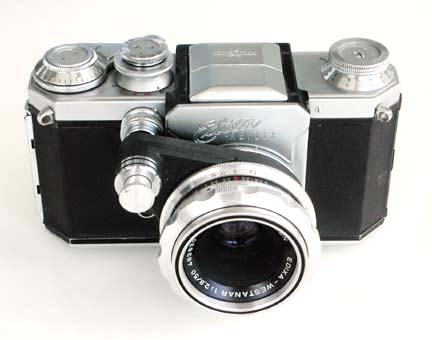
Windowshopping in Stuttgart during the summer of 1957, I saw an Edixa Reflex camera for the first time. My attention was drawn to the unusual design of the bipartite cover over the waist-level finder. Having been a tools engineer trainee at VEB Zeiss Ikon in Dresden and having spent another year at Kamera-Werkstätten in Niedersedlitz, I considered the ideal camera was the Exakta Varex which was world renowned. I wondered if, in the free and much more developed part of Germany, there could be found a corresponding SLR-camera with changeable lenses and viewfinders. The Leica and the Contax were still the most exclusive cameras in Western Germany. Obviously, there was also the attractive and reliable Contaflex with its wonderful clear viewfinder, but the Contaflex was not quite a real system camera. The Edixa Reflex represented the only camera in its class in Western Germany for which I saw a future. No wonder that the efficient, forward-looking Japanese eventually won the race. Having finished a master-training at the Zeiss Ikon AG in Stuttgart
the road took me to Scandinavia in the autumn of 1959. Kamerawerk Gebr.Wirgin, who produced the Edixa Reflex, was represented in Denmark by Belgisk Import Co. (later Bico) and was serviced by S.E. Svendsen’s business in Hellerup near Copenhagen. Mr. Svendsen asked me if I on my way north would stop by Gebr. Wirgin in order to thoroughly learn the Edixa Reflex. Thus I announced myself for duty to Wirgin’s kind export manager Mr. Pyrlik on Taunustrasse in Wiesbaden and was immediately sent out to the factory situated in some old buildings on Dotzheimer Strasse 172 just out of the city-centre.
The following 3 weeks I partook in the assembly and adjustments of the Edixa Reflex which for the first time provided me with the knowhow of an SLR camera with a focal-plane shutter.
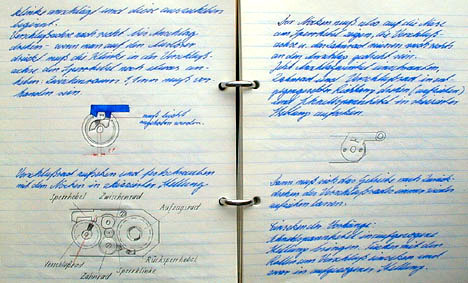
It was very interesting and constructive seeing the production methods at Gebr.Wirgin compared with the ones at Zeiss Ikon AG. At Zeiss Ikon all the camera parts were produced with the finest precision and finish, and only small adjustments were needed during assembly. At Gebr. Wirgin on the other hand the finish was much rougher, and technicians filed and polished until everything functioned satisfactorily. I was quite shocked to see how the screw heads were secured. The metal surrounding the screw head was simply struck with a conical punch to extrude the metal into contact with the screw head to lock the screw against turning. One can imagine the damage and the trouble it created for repairs. The colleagues told me that once a technician wanted to simplify the process by leaving the cameras in the transport-boxes in which they were carried along the assembly line, while the screws were hit by the tool. To the general amusement of everyone the bottom of the transport-box fell out.
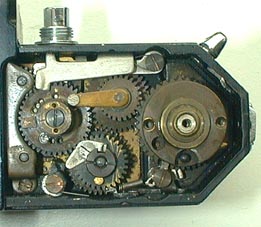
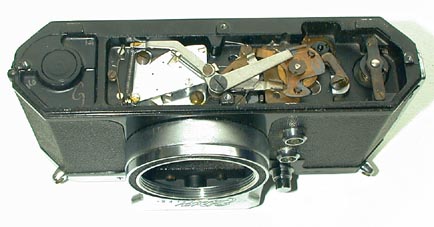
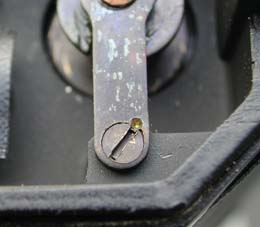
A constantly returning problem, which was never really resolved, was the uneven exposure at the short shutter speeds from 1/250 to 1/1000 second. Several times I heard excuses that the Exakta Varex was not perfect either on that point. After a time, I created my own theory why that problem was never solved. In an Edixa Reflex, as in an Exakta Varex, the shutter curtains roll on axles of a relatively small diameter. Where the ribbons of the first shutter curtain are glued onto the axle and where the second shutter curtain is placed on its drum ” a tiny hump forms. Broadly speaking these humps amount to a variable or eccentric axle diameter, which changes the width of the slit while the shutter runs over the picture frame. In the Edixa Reflex the slit starts on 1/1000 second about 1.3 mm wide. With such a narrow slit, it does not take a very big deviation of slit width during the curtain travel before the background light say in a landscape becomes uneven or striped. It does not help that the axle for the first shutter curtain is supplied with cam surfaces to operate the synchro contacts. These also create a variable friction when the shutter moves. If only Wirgin had done what Nikon did or the Russian copycats, who copied the Leica shutter. On the Leica shutter the curtains roll from a main axle and a drum with a much larger diameter, creating a much more even performance.
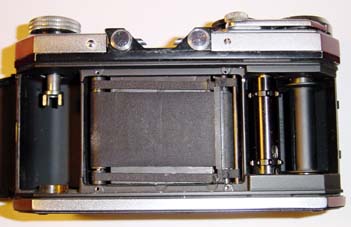
The saying goes that Henry Wirgin once was asked why they did not try to provide more precise shutter speeds. “People buy the cameras anyhow” he is supposed to have answered. I recall that occasionally I saw in Gebr. Wirgin’s montage department, behind the workshop manager’s desk, a short stocky gentleman, whose head appeared to sit directly between his shoulders. Thus he was hardly able to look above the edge of the desk. This was Henry Wirgin the company’s owner. My colleagues told me about his stinginess and imitated his reactions when they talked to him about new instruments ,i.e., better tools. He would wave his arms about him and announce in his forceful, rather nasal voice “Kein Geld, zu teuer, kein Geld!” (“No money, too expensive, no money!”)
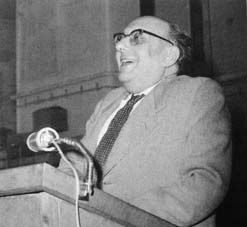
Who was Henry Wirgin really, or the Wirgin brothers for that matter? The four brothers Wolf, Joseph, Heinrich and Max Wirgin originated from Radom, Poland. They looked for a higher education in Germany and Switzerland. In the twenties they started a camera factory in Wiesbaden. They produced folding cameras called Philos, Presto, Westex, Alwe and Gewir. (The name “Gewir” is almost certainly derived from GEbr. WIRgin.) Depending on the price range they were equipped with Compur or Prontor shutters and with Steinheil or Schneider lenses, or with lenses called Gewironar.
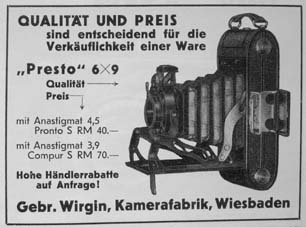
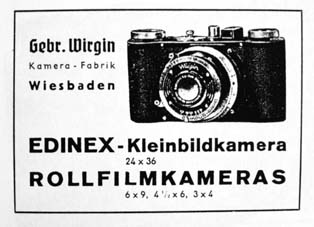
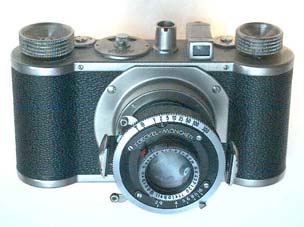
A twin-lens Wirgin camera existed, similar to the Voigtländer Brillant. They experimented with the newly discovered material bakelite, making a camera called the Baky. A little metal camera for 127-film was called Gewirette, while the 35mm format was addressed by the compact little Edinex camera. The Edinex is also known as “Adox Adrette“. This has its
own dramatic story.
Being Jewish, the Wirgin brothers in Nazi Germany were exposed to increasing threats, disputes and hounding. They left Germany about 1938. In the middle of the night Heinrich was helped over the Swiss border by his faithful gateman, driver and general drudge Seppl Haas. Heinrich continued on to the USA and became “Henry” Wirgin. The company was confiscated and after some haggling with authorities was bought by Dr. C. Schleussner, Frankfurt, who really specialised in films, photopaper and chemicals. Now Dr. Schleussner also became a camera producer under the name Adox. It cannot have taken long before production at the factory in Wiesbaden was changed to war purposes, as happened to all the German industries. Wiesbaden was badly bombed and the factory in Dotzheimer Strasse was partly destroyed. Henry Wirgin returned after the war. Apparently he was not a person to bear a grudge, and he regained his factory. The unconfirmed tale has it that he re-bought the factory for 33 cartons of American cigarettes. In Wiesbaden-Biebrich Dr. Schleussner’s Adox continued its own camera production using the equipment which had been bought during the take-over of 1938. Henry Wirgin carried on from where he had left off. The Edinex 35mm camera was developed further and later replaced by the little Edina. Kodak was not pleased with that name, being too close to Retina, so the camera became the Edixa.
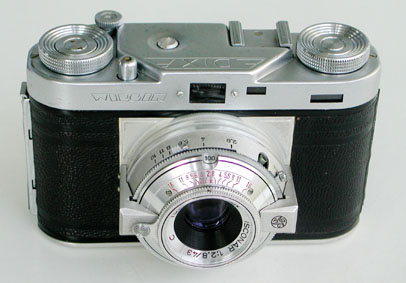
As there was a demand for a stereo camera, Wirgin said “aus eins mach zwei” (from one make two) and shunted two small Edixas together in order to make the Edixa Stereo, which was produced in three variations: with a simple viewfinder, with a rangefinder and, in the most expensive model, with both a rangefinder and a lightmeter.
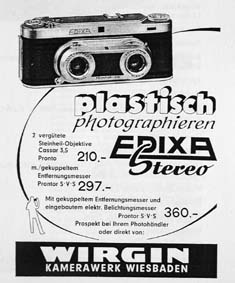
Henry Wirgin was extremely lucky that in 1950 the young and inventive precision engineer Heinz Waaske knocked on his door. Heinz Waaske was a trainee with Telefunken before the war, was later called up for military service and returned, having been seriously wounded on the Eastern front. Heinz Waaske was looking for new pastures and ended up with Wirgin in Wiesbaden. The story is told that he one day declared “Now I want to design an SLR camera”. Henry Wirgin bought the idea, being aware that Western Germany lacked a competitor for the East German Exakta and Praktica. The new camera was known at first as the Komet. In a way it was similar to its role models, as the shutter release button was on the front of the camera as in the Praktica, the screw mount of the lens was also 42 mm, and the shutter speed knob turned around during the exposure as in the Exakta and Praktica. These resemblances did not occur by chance either, as several of the technicians who worked on the new design came from Ihagee in Dresden. One of these technicians was Otto Helfricht, who was with the team which in the thirties, together with Carl Nüchterlein, had developed the famous Kine Exakta.
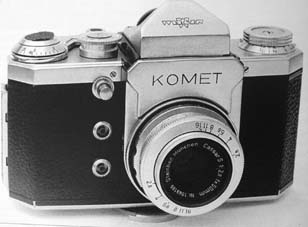
Wirgin’s new SLR camera was not allowed to be called Komet for very long. Fichtel & Sachs protested as their company already had a product of that name. What would be better than calling it Edixa Reflex, and so this is the name by which it became known. There may be some confusion regarding the different Edixa Reflex models; basically the following exist:
- Model A: the basic model without internal automatic diaphragm mechanism
- Model B: the model with internal automatic diaphragm mechanism
- Model C: the model with the lightmeter (made by Metrawatt)
- Model D: the model with governor for selftimer and long time exposures
(max. 9 sec.)
In 1960 the body of the camera was modernised by giving the exposure counter scale, the shutter speed knob and the rewind knob a black finish. About the same time “mat” was included in the name, which referred to the instant-return mirror which caused the viewfinder to become clear again after the exposure.
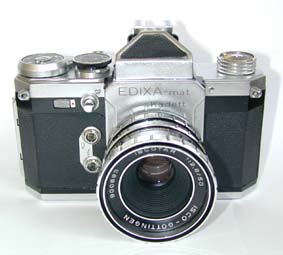
From about 1958 Heinz Waaske concentrated on a project which was to become a sensation at Photokina 1960, the Edixa Electronica. The camera was remarkable with its streamlined design and its motorised automatic exposure control, which with a pressure on the so-called “Reglertaste” (regulator-key) turned the aperture ring to the correct value. If correct exposure could not be achieved by changing the aperture alone, the system continued by turning the ring for the shutter speed until the correct exposure was achieved. Even though the Edixa Electronica was equipped with a Synchro Compur leaf-shutter, the lenses were changeable from 28mm to 135mm.
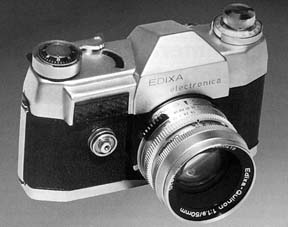
Unfortunately the Edixa Electronica suffered a sad ending. Max Wirgin, who in the USA represented both Edixa Reflex and other brands, during the Photokina rushed up to Henry Wirgin and cried out: “Get rid of that rubbish. It spoils everything!” What had happened was Max Wirgin and the other producers had noticed that the Edixa Electronica superceded all of their existing SLRs in design and technique. They now threatened Max Wirgin with fire and brimstone if he insisted on selling the camera. Max persuaded Henry to withhold the Edixa Electronica. By the time it was released on the market in 1962 all was lost. The Japanese had scored a bull’s eye and released fully automatic cameras already. I recall having handled an Edixa Electronica then. I do not think that even a single camera was sold in Denmark. The production was stopped in 1965 after approximately 4000 cameras had reached the market.
Heinz Waaske, who was Wirgin’s chief designer had a weakness for subminiature cameras. He developed the attractive little Edixa 16 which today is quite sought after by collectors. The department store Karstadt sold this camera as the Alka, and when Henry Wirgin bought out the Franka camera factories, the Edixa 16 was also sold under the Franka name.
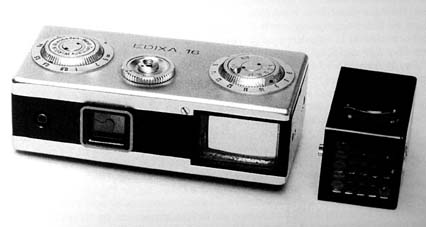
The most exciting project on Heinz Waaske’s drawing board was a miniature 35mm format camera. It was to become a resounding success, but not under the Wirgin name. Heinz Waaske had already tried to persuade his boss to produce this camera, and he had even made a model. But Henry Wirgin did not take the bit in his teeth. Perhaps the fiasco with the Edixa Electronica was too recent in his memory. Leitz in Wetzlar was presented with the idea, but refused politely. Heinz Waaske had more luck with Franke & Heidecke in Braunschweig. Rolleiflex sales, which had been outstanding, were by this time on a downward trend and the company apparently lacked a replacement. Henry Waaske’s invention must have seemed like a gift from heaven. Today everyone knows how popular the little Rollei 35 became.
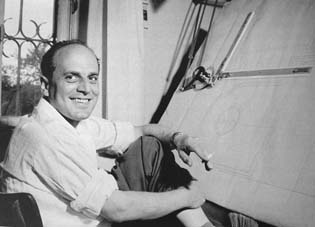
In 1965 Heinz Waaske resigned from Wirgin and moved to Braunschweig. He stayed with Franke & Heidecke till 1978, after which he started up his own design workshop. He resolved problems for Minox and others. 1995 the gifted camera-designer died at 71 years of age. At Gebr.Wirgin they continued to improve the Edixa Reflex without developing anything that was very original. The Edixa Prismat had a permanent prism, and the Edixa rex was equipped with a bayonet mount, which was not a success and they reverted to the screw mount. Edixa Reflex cameras with CDS cell and TTL lightmeter also appeared. With every little alteration a new name was given to what was basically the same camera. In the end an excessive number of models existed. I do not remember having seen all of these models in Denmark. Meanwhile Nikon and other Japanese SLR cameras were taking over the market. In the same way the sales of the Edixa Reflex must have stagnated also in other countries.
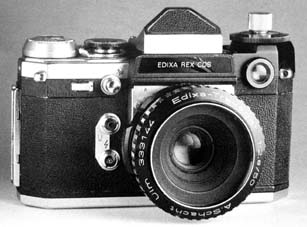
In 1968 Henry Wirgin threw in the towel. The successor of Kamerawerk Gebr.Wirgin was Edixa GmbH, formed with Otto Helfricht as the factory manager and Mr.Pyrlik, who once welcomed me, as a member of the board. They experimented with a completely new Edixa Electronica TL in a modern black design. The development swallowed fortunes, since both the shutter and electronics gave problems, thus in the end the camera turned out to be a white elephant.
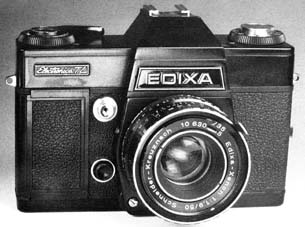
In 1972 everything was finished. Edixa GmbH had to close down and to turn the key in the door for the last time. It was altogether a very sad time for the German camera industry. Zeiss Ikon and Voigtländer closed down at the same time. Dr.Schleussner’s Adox Kamerawerk had already ceased production in 1964. In Dresden, Ihagee lost its independence and was swallowed up by VEB Pentacon. Our main character became a very old man. Henry Wirgin died at the age of 91 years in 1989 and found his last resting place next to his dear wife Esther in the cemetery in Wiesbaden. This brings us to the end of the fascinating story about this creative man and his Edixa Reflex camera.
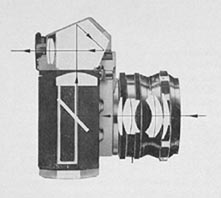
Sources:
- My own memories and notes
- Udo Afalter: “Edixa ” Kameras & Objektive”
- Jörg Eikmann/Ulrich Voigt: “Kameras für Millionen” a book about Heinz Waaske
- PhotoDeal: “Wirgin Edixa ” eine deutsche Geschichte” 5 articles by Günther Kadlubek
Thanks to Laila Trevor and Robert Stoddard for their kind assistance
